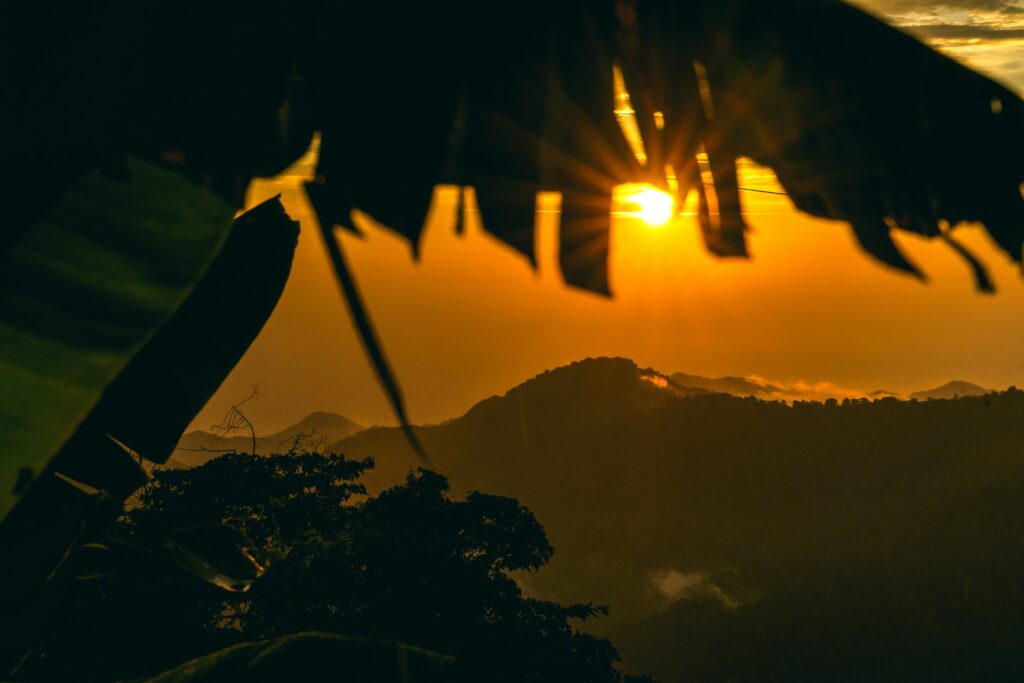Preview
Deep in the Sierra Nevada de Santa Marta lives a people who have remained rooted in wisdom, even as the world around them changed. Who are they? What can they teach us? And why does their voice matter now?
They are the Arhuaco — an Indigenous people whose origins trace back to the ancient Tairona civilization, one of the most sophisticated cultures of pre-Columbian Colombia.
For centuries, they’ve preserved a way of life guided by balance, ancestral memory, and a spiritual connection to the Earth. In a time of ecological crisis and cultural upheaval, their message carries more weight than ever: we must remember how to live in harmony with the world that sustains us.
Who Are the Arhuaco?
Tucked high in the cloud-kissed peaks of Colombia’s Sierra Nevada de Santa Marta, the Arhuaco people live in a world shaped by mountains, memory, and meaning. With flowing white garments and handwoven bags etched with sacred symbols, they walk quietly through a land they see not just as home — but as sacred.
The Arhuaco are one of four Indigenous groups who inhabit the Sierra Nevada, alongside the Kogi, Wiwa, and Kankuamo. Together, they are considered the spiritual heirs of the Tairona, an ancient civilization that flourished long before European contact. But unlike most cultures fractured by conquest, the Arhuaco have maintained their identity across generations through devotion to ancestral law, community, and a deep spiritual connection to the Earth.
To outsiders, they may seem remote. To themselves, they are caretakers of the “Heart of the World.”
Ancient Roots, Living Resistance
The Arhuaco descend directly from the Tairona, a pre-Columbian civilization renowned for its stone-built cities, ornate goldwork, and sophisticated ecological knowledge. The Tairona thrived for centuries across the Caribbean slopes of northern Colombia — until the arrival of the Spanish in the 1500s.
Rather than surrender to colonial forces, the Tairona withdrew into the mountains, abandoning their coastal settlements in order to protect their culture, language, and cosmology. In the centuries that followed, their descendants — including the Arhuaco — continued to live in secluded highland communities, preserving what could not be erased: their spiritual laws, their harmony with nature, and their collective memory.
This act of retreat was not submission. It was resistance through resilience — a decision to endure without assimilating, to protect knowledge not by force, but by outlasting time.
Today, the Arhuaco walk the same ancient paths their ancestors once traveled. In their rituals, language, and worldview, the heartbeat of the Tairona still echoes — quietly, but unwavering.
A Culture Woven with the Cosmos
The Arhuaco didn’t just survive history — they carried their world into the present, intact and alive. From their ancestors, the Tairona, they inherited more than stonework and gold — they inherited a way of seeing: a sacred blueprint where nature, spirit, and community are one.
At the heart of that worldview is Aluna — the origin of all things. Not a place, but a consciousness. A vast, invisible realm of thought where rivers are born, mountains are dreamed, and balance is written before it’s lived. The Arhuaco believe that what happens in Aluna shapes what happens here — and when imbalance begins in thought, it ripples into drought, disease, even war.
To guide these unseen dynamics, the Arhuaco turn to their Mamos — spiritual leaders trained not through books, but through silence, observation, and deep communion with nature. Chosen in childhood, Mamos undergo years of isolated training, learning to “read” the mountain, interpret dreams, and conduct sacred offerings. They are not preachers. They are guardians of balance, interpreters of the law that binds all life.
But this isn’t abstract. Their cosmology is woven directly into what they wear, make, and carry. Their white clothing mirrors the snow-draped peaks of the Sierra — a symbol of purity and alignment with the sacred. The iconic conical hats, worn by Arhuaco men, echo the shape of those very mountains, grounding their identity in place and purpose.
Perhaps most striking are the mochilas — handwoven bags crafted by Arhuaco women. Each one is a message: its patterns speak of stars, rivers, animals, dreams. To weave a mochila is to meditate. To carry one is to carry meaning.
Their language, Ikʉ, expresses these ideas with precision. Words don’t just describe — they connect, symbolize, invoke. A river isn’t just a river; it’s a spirit. A stone isn’t just a stone; it remembers.
In a world that often severs the physical from the sacred, the Arhuaco refuse to divide the two. Their culture is not performance. It’s law. It’s memory. It’s a form of resistance that doesn’t shout — it whispers through centuries.
And that whisper is still audible — if we’re willing to listen.
Modern Arhuaco: Guardians in the 21st Century
Despite their highland isolation, the Arhuaco are not untouched by the outside world — far from it. They’ve endured generations of interference, from colonization and forced religious conversion to armed conflict, illegal mining, and environmental degradation. Yet through it all, they’ve done what they’ve always done: adapt without surrender.
Their ancestral capital, Nabusímake, once overtaken by Catholic missionaries, is now firmly back in Arhuaco hands. In 1982, in a peaceful but defiant act of resistance, the community reclaimed the town, expelling the missionaries and reestablishing control over their own education, language, and cultural transmission. Today, children learn in both Spanish and Ikʉ, and spiritual teachings are once again passed down alongside math and history.
While much of the world looks at technology and progress as the future, the Arhuaco see something else: sustainability, memory, balance. They’ve embraced tools that protect their autonomy — legal frameworks, international advocacy, fair trade — but they wield them with intention.
Take, for example, their response to global demand. Arhuaco women now sell their mochilas beyond the Sierra, not as souvenirs, but as ambassadors of meaning. Coffee cooperatives like ANEI support organic, Indigenous-led farming, turning regenerative agriculture into both livelihood and statement.
In recent decades, Arhuaco leaders have stepped onto national and international stages — not to assimilate, but to amplify their message. In 2022, Leonor Zalabata, a respected Arhuaco human rights advocate, became Colombia’s Ambassador to the United Nations. From Nabusímake to New York, the Arhuaco voice is being heard.
But threats remain. Climate change is melting the sacred glaciers of the Sierra. Mining interests hover over ancestral lands. Armed groups still haunt the region’s periphery. And yet, the Arhuaco endure — holding ceremonies at sacred sites, lobbying the courts, reforesting their hillsides tree by tree.
They don’t call it activism. They call it responsibility.
In a world that often asks, “What can we take?” the Arhuaco continue to ask, “What can we give back?”
What Can We Learn from the Arhuaco?
In a time when the world is spinning faster, burning hotter, and forgetting deeper, the Arhuaco offer something profoundly rare: a living memory of balance.
They remind us that wisdom doesn’t always wear a lab coat or a suit. Sometimes, it wears white cotton, walks barefoot through the mountains, and speaks in metaphors older than empires.
From the Arhuaco, we learn that progress isn’t always forward. Sometimes it’s inward — into silence, into thought, into Aluna. That resistance can look like weaving, planting, remembering. That the Earth is not a resource — it’s a relative.
Their message isn’t just for Indigenous peoples. It’s for all of us — especially those of us who have been taught to separate the spiritual from the ecological, the cultural from the practical.
We don’t need to become Arhuaco to listen like them.
To walk slower.
To pay attention.
To remember that thought creates reality — and that the world we live in is the one we imagine first.
Maybe the question isn’t just what can we learn from the Arhuaco?
Maybe it’s what are we willing to unlearn?
Travel with Respect: A Note for Visitors
If the Arhuaco have sparked your curiosity — good. Curiosity is a powerful first step. But when curiosity leads us to Indigenous lands, it must walk hand-in-hand with respect, restraint, and reciprocity.
The Arhuaco are not a tourist attraction. They are a sovereign people living according to sacred rhythms. Much of their territory, including Nabusímake, is not open to uninvited tourism — and that boundary should be honored. Access is sometimes granted through official Indigenous councils, but it’s never guaranteed, nor should it be expected.
So how can we engage with integrity?
-
- Support Arhuaco artisans directly. If you buy a mochila, make sure it’s from a verified cooperative or community vendor — not a knockoff.
-
- Uplift Arhuaco voices. Share their films, their words, their leaders’ advocacy. Follow Indigenous-led media.
-
- Learn before you go. Regenerative travel starts with education — not extraction.
-
- Ask better questions. Don’t just wonder what you can see. Ask what you can unsee — and what systems you might be part of that others are healing from.
Being a good guest starts long before you arrive. And sometimes, the most respectful way to engage… is to stay curious from afar.
Sources
Primary Sources & Cultural Insight
-
UNESCO Intangible Heritage Listing: Knowledge of the four Indigenous peoples of the Sierra Nevada de Santa Marta
-
BBC Documentary — From the Heart of the World: The Elder Brother’s Warning (1990)
-
Film — Aluna (2012), created in collaboration with the Kogi and Arhuaco peoples
-
Tayrona Indigenous Confederation (CIT) – Official Indigenous council
Historical and Anthropological Context
-
Van Cott, Donna Lee. From Movements to Parties in Latin America: The Evolution of Ethnic Politics
-
Reichel-Dolmatoff, Gerardo. The Sacred and the Profane in Tairona Culture
-
Franky Calvo, Carlos. Los Arhuacos: Sociedad, cultura y espiritualidad
Journalism and Contemporary Reports
-
Cultural Survival: Indigenous reports and updates on the Arhuaco
-
Pulitzer Center: Profiles of Arhuaco leaders and spiritual ecology
-
Colombia Reports: “Indigenous ambassador to UN” (2022)
-
Greenwood Energy: Historical overview of Arhuaco resistance (archived)
Academic/NGO Reports
-
Minority Rights Group International: Profile on the Arhuaco
-
Amazon Frontlines: Defense of sacred sites and legal advocacy
 Support
Support
-
- ANEI Coffee Cooperative – Organic Arhuaco-grown coffee anei.org
-
- Arhuaco Mochila Collectives – Look for Indigenous-certified vendors or NGO partnerships (e.g., Manos de Colombia)

